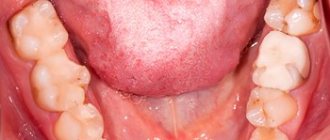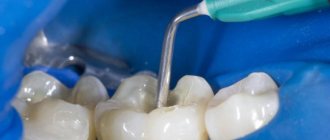Alcohol after dental treatment
The effect of alcohol on a treated tooth
How long after dental treatment can you drink alcohol?
Is it possible to drink carbonated or foamy drinks after dental treatment?
Is it possible to smoke after surgery?
A toothache can strike at the most unexpected moment, including before a planned feast. Is it possible to drink alcohol after dental treatment? What consequences can this lead to?
Indications
Let's figure out when the use of arsenic is acceptable and justified. Most often, arsenic paste is used when it is not possible to use other analgesics. This substance is used to kill nerve endings and blood vessels in the pulp. Arsenic paste can be used in the following situations:
- it is impossible to use another type of anesthesia due to the patient’s health condition (high blood pressure, alcohol intoxication);
- urgent emergency treatment and absence of other anesthetics;
- allergy to other painkillers;
- lack of effectiveness of other anesthetic drugs due to the patient’s high pain threshold;
- when treating baby teeth in children, when local anesthesia cannot be performed (the child is afraid of injections).
The effect of alcohol on a treated tooth
Some people think that alcohol after dental treatment additionally disinfects the oral cavity, but doctors say the opposite. After dental treatment, especially after treatment of pulpitis or periodontitis, the body needs rest. Not only the daily routine should be gentle, but also the diet, so at this time it is better to give up alcoholic beverages.
Let's tell you why.
- Alcohol can cause bleeding because alcohol dilates blood vessels and increases blood pressure.
- When drinking alcohol, the oral mucosa is irritated, the healing process slows down, and the risk of inflammation increases.
- Alcohol increases the load on the cardiovascular system and liver.
- Alcoholic drinks in combination with an anesthetic can cause headache, weakness, and convulsions.
Despite the fact that the effect of anesthesia wears off on average after two hours, the breakdown products continue to remain in the body for several more days.
How long can an adult keep arsenic in a tooth?
Depulpation of a dental element is a procedure that allows you to kill a painful nerve that worries the patient. This manipulation requires the use of special painkillers, one of which is arsenic. To necrotize the dental nerve, arsenic paste is placed into the canal. To achieve the desired effect, the product must be kept for a certain time. Therefore, it is very important to know how much arsenic should be kept in the dental element.
Use in dentistry Arsenic paste is used in the treatment of pulpitis for the purpose of analgesic effects on the pulp. However, in this case there are indications and contraindications.
Arsenic must be used:
when a patient may have an allergic reaction to an anesthetic drug;
if the anesthetic drug used does not have the maximum effect;
there is not enough time for the anesthetic drug to take effect;
if the patient has recently suffered a heart attack;
the patient has hypertension;
the patient is under the influence of alcohol. Contraindications:
when the patient has an allergic reaction to arsenic or anesthetic drugs that contain arsenic;
if a child under three years old needs dental treatment;
tooth roots are not sufficiently formed;
if the patient is diagnosed with glaucoma;
when the patient has pathologies of the genitourinary system;
perforation of the roots of dental elements was diagnosed. Stages of treatment
The initiation of therapy must necessarily begin with an examination using an x-ray. Then, if the pathology is confirmed, the specialist opens the carious cavity and removes dead tissue. Arsenic paste is placed into the cleaned channel. The final steps include filling the dental element with a temporary filling. The doctor determines the duration of arsenic exposure. The second visit is characterized by the removal of arsenic from the tooth and the dead nerve is removed. This manipulation is absolutely painless.
How long should you keep arsenic paste in your tooth?
It is very important to determine how much arsenic should be kept. There are a lot of criteria here - the patient’s age, the drug used, pulp indicators (the drug is placed on a closed pulp or an open one). The average duration of exposure to arsenic on a nerve is 1 day. If multiple treatments are necessary, the doctor will increase the duration of action to two days. If we are talking about the treatment of dental elements of children, then the extraction of arsenic should occur no later than 16 hours later.
Attention! There are modern medicines that contain arsenic. Their effect on the diseased nerve can be increased to five days. Recommendations
Since arsenic paste is poisonous, safety rules must be followed. It is important to come to your next appointment at the time agreed with your doctor. First of all, follow this list of rules:
1) Maintain the integrity of the temporary filling. Initially, the filling is made airtight, so arsenic acts exclusively on the diseased nerve. If the integrity of the filling is damaged, arsenic comes out and affects the surrounding tissues. As a result, an inflammatory process occurs, which is accompanied by painful sensations.
2) Do not exceed the period of exposure to arsenic.
3) The specialist should not make a mistake with the dosage of the product.
What to do if you experience discomfort? Often the patient may experience discomfort when exposed to arsenic, to minimize anxiety, it is recommended:
rinse your mouth with soda solution if there is a sour taste. In this way, the acidic effect can be neutralized and burns can be avoided; after arsenic is introduced into the tooth, pain may occur; a glass of warm milk will be required to relieve it. To do this, hold the milk in your mouth for a few seconds, and then drink the drink completely.
Reference! Milk, namely the protein it contains, quickly removes arsenic from the body. How harmful is arsenic?
Since this product is a type of poison, it is used for dental purposes in minimal dosages, with strict adherence to safety rules. Proper use of arsenic minimizes harmful effects.
If the timing of exposure to arsenic is violated, it can penetrate the tissue structure, accumulate there and cause complications. If some of the arsenic gets into the oral cavity, then a protracted inflammatory process should be expected.
With incorrect dosages of arsenic, the following consequences are observed: 1) Dentin begins to blacken.
2) Swelling and inflammation of the pulp occurs.
3) Toxic effects on the body.
4) Inflammatory process of periodontal tissue.
5) Osteonecrosis.
Very often, the patient may ignore the deadlines indicated by the specialist. As a result, arsenic periodontitis occurs, the treatment of which requires a long time. When exposed to arsenic, tissue necrosis cannot be ruled out. If the patient experiences increased sensitivity, toxic damage to the intestines and liver subsequently occurs. Arsenic extraction process
In the depulpation procedure, it is very important to remove arsenic in a timely manner. If you ignore this indicator, you can get the above complications.
Advice! When the patient is unable to visit the doctor at the appointed time, the arsenic must be extracted independently. To do this, wash your hands and disinfect them in advance. Then break the integrity of the seal and remove the arsenic. The danger of manipulation is that it can be swallowed. Therefore, procedures should be carried out with extreme caution. Upon completion of the manipulation, the oral cavity must be rinsed with a soda solution. In this case, visit the dentist as soon as possible. Use of arsenic for pregnant women
If a woman is a nursing mother or is pregnant, then the use of products containing arsenic is strictly prohibited. This is due to the toxic effect on the baby. When a woman is short of pregnancy, it is important to warn the dentist about the situation. Modern dentistry is rich in safer medications that are approved for use by pregnant women. It is important! Additionally, auxiliary substances can be added to the paste, which are necessary for preparing a small dose.
The patient must remember that in no case should the duration of exposure to arsenic on the diseased nerve be exceeded, because this is fraught with dangerous consequences.
Dental treatment at the AVANTA dental clinic in St. Petersburg. Our specialists will conduct an initial examination and advise you. We are located next to the Mezhdunarodnaya metro station, at the address: Frunzensky district, Bela Kun street, building 2, building 1.
#dental treatment #dentistry
Is it possible to drink carbonated or foamy drinks after dental treatment?
Gas is a constant irritant to the tooth, and foamy drinks (for example, kvass) contain yeast, which can get into the wound and cause discomfort. In addition, in the first days after tooth extraction, it is not recommended to drink drinks from straws. When sucking any drink, a vacuum is created in the mouth, which can tear a blood clot out of the hole.
How to get rid of arsenic without medical help
If the timing of using the drug for therapeutic purposes has been missed, and it is not possible to visit the dentist’s office, you can try to extract the paste yourself.
- First of all, maintain hygiene: clean hands, clean teeth. Instruments also need to be disinfected. This could be tweezers, a large sewing (or medical) needle. It is best to boil them and keep them in vodka or potassium permanganate.
Alcohol for sterilizing needles
- It is convenient to remove the temporary filling at the mirror. The main thing is not to touch neighboring healthy tissues and not to go deeper into the dental cavity.
- Under the filling there will be a grayish paste. It must be removed carefully so as not to crumble and swallow arsenic.
- Then the tooth cavity is thoroughly rinsed with a solution of soda or chamomile infusion.
Chamomile infusion for mouth rinse after filling removal
- The tooth cavity is closed with a cotton swab.
After such self-help, you should visit the dentist as soon as possible, since the decaying nerve will contribute to the development of inflammatory processes. If the paste is left in the mouth longer than expected, the paste will destroy the periapical tissue adjacent to the pulp. The next stage will be the occurrence of periodontitis. After just 3 days, the tooth will begin to turn black and decay.
Don't put off visiting the dentist
How toxic is the drug?
Today in dentistry, arsenic paste is used strictly according to indications, since if recommendations are violated or individual characteristics are violated, its toxic properties still manifest themselves. If you take treatment carelessly, complications are possible:
- darkening of dentin;
- development of periodontitis;
- swelling of the pulp;
- necrosis of bone and periosteum;
- general intoxication of the body.
Periodontitis and pulpitis
Today, arsenic paste is contraindicated for pregnant women and children due to its high toxicity, since many new methods for treating pulpitis have been developed.
Arsenic is not used to treat the teeth of pregnant women
Life time
The service life of a temporary filling varies from 3-4 days to 2-3 weeks. The exact timing depends on the specific dental disease and the drugs used in treatment.
Here's how much a temporary filling can cost in different situations:
- when using arsenic paste to kill a diseased nerve - no more than 2-3 days (usually 24-28 hours), when using other means (for example, paraform paste) for the same purposes - 5-10 days;
- when using antibiotics and antiseptics in the treatment of deep caries or pulpitis - from 3-4 days to 2-3 weeks;
- in particularly complex diagnostic cases – up to 3 and even 6 months.
If you can’t get to the doctor on time, be sure to notify him in advance. In this case, if possible, he will try to place the most durable reflective filling that can be safely worn for several months.
Potential problems
Problems that may arise after installing a temporary filling:
- Tolerable and not too severe toothache after filling is caused by several reasons: infection, the actual surgical intervention and incompletely killed pulp. But, if the pain is very severe, this may mean that the nerve is inflamed, periodontitis or pulpitis is developing, a cyst has formed, or there is an allergy to filling materials. In this case, only visiting a dentist will help.
- If the filling crumbles badly or falls out, you need to urgently run to the doctor, otherwise an infection will penetrate into the affected tooth and treatment will have to be started in the second round.
- Some antiseptic and medicinal preparations used in the treatment of dental canals have a distinct, specific taste. Therefore, a medicinal taste in the mouth for several days after filling is quite normal, albeit unpleasant. You can beat it off (or soften it) by rinsing. But, if the taste is very persistent, this may mean that the filling is cracked, and then you will still have to go to the doctor.
If the filling darkens, bad breath appears, the gums above (under) the affected tooth turn red or fester, you should also rush to the dentist.










